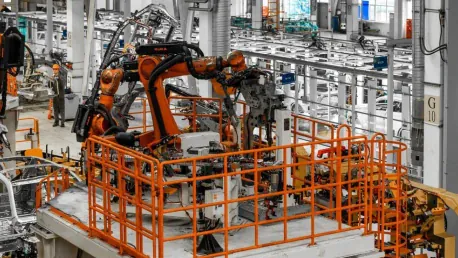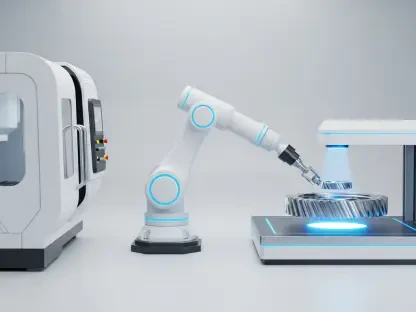The global manufacturing industry faces substantial challenges related to energy consumption and greenhouse gas emissions. As the world moves towards more sustainable practices, smart factories are emerging as a potential solution. Smart factories utilize advanced technologies for optimized production processes, aiming to reduce waste and enhance energy efficiency. However, the short-term environmental impacts of constructing these facilities remain debated. This article delves into how the implementation of smart factories affects the environmental performance of manufacturing firms in China, based on a study of 144 listed firms.
Understanding Smart Factories
Definition and Key Features
Smart factories stand at the forefront of Industry 4.0, characterized by advanced manufacturing technologies like the Internet of Things (IoT), artificial intelligence (AI), and machine learning (ML). These facilities are designed to seamlessly integrate data from production operations, enabling enhanced decision-making, process optimization, and energy efficiency. The interconnectivity and data-driven nature of smart factories mark a significant departure from traditional manufacturing environments, making them more adaptive and intelligent. This results in real-time visibility into manufacturing performance, allowing companies to swiftly identify and rectify inefficiencies.
Furthermore, smart factories embody a high degree of automation, reducing reliance on manual intervention and thus minimizing human error. Robotics and advanced machinery play crucial roles in the production processes, ensuring consistent quality and improving overall productivity. Another notable feature is predictive maintenance, where IoT sensors and AI algorithms work together to identify potential equipment failures before they occur. This not only prevents costly downtimes but also extends the lifespan of the machinery, contributing to economic efficiency.
Core Technologies in Smart Factories
At the heart of smart factories are technologies that enable real-time monitoring and predictive maintenance. IoT devices collect vast amounts of data from connected machinery, while AI algorithms analyze this data to predict potential failures and optimize production schedules. Machine learning models continuously improve by learning from operational data, leading to more efficient processes over time. The deployment of digital twins—virtual replicas of physical assets—further enhances the capability to simulate, predict, and optimize manufacturing operations.
These digital twins serve as real-time simulation tools, enabling manufacturers to foresee the impact of decisions on the production line without physical trials. The integration of cloud computing plays a critical role in managing and processing the extensive datasets generated, ensuring seamless data accessibility and heightened processing power. In essence, these core technologies work in unison to create a dynamic and responsive manufacturing environment where decisions are data-driven and processes are self-optimizing.
Potential Pitfalls
Despite their promising capabilities, smart factories are not devoid of challenges. The energy-intensive nature of the technologies used, such as powerful data centers and high-capacity sensors, can lead to increased energy consumption and, consequently, higher greenhouse gas (GHG) emissions, especially during the initial phases of implementation. This initial surge in energy demand can offset the benefits anticipated from enhanced efficiency and reduced waste. Additionally, the complex integration of various advanced technologies necessitates significant capital investment and expertise, potentially posing a barrier for many firms.
Another concern is the cybersecurity risk associated with the highly connected nature of smart factories. The vast amount of data generated and the reliance on internet-enabled devices make these systems vulnerable to cyberattacks, which can lead to operational disruptions and significant financial losses. Finally, regulatory compliance remains another critical challenge, as firms must navigate complex environmental regulations to ensure their smart factories not only achieve productivity gains but also meet stringent sustainability standards.
Empirical Evidence from Chinese Manufacturing Firms
Research Methodology
To understand the environmental impact of smart factories, researchers employed a robust methodology involving propensity score matching (PSM) and difference-in-differences (DID) models. This approach allowed for a precise comparison between firms that constructed smart factories and those that did not, focusing on data from 144 Chinese listed manufacturing firms between 2012 and 2021. The PSM method ensured that firms with similar characteristics were compared, thereby minimizing biases due to observable variables. The DID model, on the other hand, controlled for time-invariant differences between the treated and control groups, providing more reliable causal estimates.
Through this dual approach, the study provided a nuanced understanding of the short-term impacts of smart factory construction on environmental performance. The researchers meticulously gathered data related to GHG emissions, air pollutants costs, and other environmental metrics, ensuring a comprehensive assessment. This rigorous methodology was pivotal in isolating the effects of smart factory construction from other external factors that might influence environmental performance.
Findings on Greenhouse Gas Emissions
The study revealed that in the short term, the construction of smart factories led to an increase in GHG emissions. This rise is attributable to the significant energy demands of smart factory technologies. These findings highlight the importance of considering energy-efficient solutions when transitioning to smart manufacturing. Specifically, during the initial phase of smart factory implementation, the increased energy consumption from advanced machinery, sensors, and data centers overshadowed the potential efficiency gains.
This finding underscores the necessity for a phased and well-planned transition to smart manufacturing, where energy efficiency is given paramount importance. It also indicates that the environmental benefits of smart factories may only become evident in the long term as the technologies mature and firms adapt to optimized operations. This transient rise in emissions serves as a critical reminder for policymakers and firms to invest in green energy sources and energy-saving technologies from the outset to mitigate adverse environmental impacts.
Impact on Air Pollutant Costs
In addition to GHG emissions, the study found that air pollutants costs per unit of operation also increased. The implementation of smart factories brought about higher levels of pollutants due to heightened energy usage. However, this cost is often seen as a temporary spike with the potential for long-term benefits as technologies become more efficient. The initial increase in air pollutants can be linked to the intensive use of electrical power and the combustion of fossil fuels in energy-hungry processes and data centers.
Nonetheless, as firms gain operational experience and technologies advance, these pollutant costs are expected to decline. For instance, the adoption of more energy-efficient machines and the integration of renewable energy sources can substantially cut down pollutant levels. Moreover, improvements in AI and ML algorithms can lead to more precise control over production processes, further reducing waste and emissions over time. Firms are encouraged to prioritize energy efficiency and sustainable practices to offset these short-term environmental costs and eventually achieve a net positive impact.
Role of Physical and Digital Technologies
Physical Technologies and Energy Use
The physical components of smart factories, including machinery and connected devices, are major contributors to the initial increase in energy consumption. These technologies require substantial power to function effectively, leading to a rise in emissions. This underscores the necessity for innovations that focus on energy efficiency within these physical systems. For example, the development and deployment of low-energy-consuming machinery and smart sensors can significantly reduce the energy footprint of smart factories.
In addition to efficient machinery, the layout and operational protocols within smart factories can also influence energy use. By optimizing the spatial arrangement of machinery and employing real-time monitoring systems, firms can minimize energy wastage due to idle times and suboptimal operations. Investing in regenerative energy solutions, such as energy recovery systems and high-efficiency motors, can further alleviate the energy demand of physical technologies in smart factories.
Digital Technologies and Data Centers
On the digital front, the operation of powerful data centers and servers plays a crucial role in the environmental impact of smart factories. The processing and storage of massive amounts of data require high energy input, which can contribute significantly to overall emissions. Efforts to develop more energy-efficient data centers and utilize renewable energy sources are essential. Cloud computing, edge computing, and AI-driven optimization can be leveraged to reduce energy requirements significantly.
For instance, data centers optimized by AI can dynamically adjust power consumption based on real-time workloads, thereby reducing unnecessary energy use. Furthermore, edge computing allows for data processing closer to the source—such as on factory floors—reducing the need for extensive data transmission and lessening the load on central data centers. Utilizing renewable energy options like solar, wind, or hydroelectric power for data center operations can help offset the carbon footprint and make digital aspects of smart factories more environmentally sustainable.
Balancing Technological Benefits and Environmental Costs
While the technological advancements in smart factories offer numerous benefits, including enhanced productivity and reduced waste, the environmental costs cannot be overlooked. A balanced approach that incorporates both technological and environmental considerations is critical for sustainable manufacturing practices. Firms should adopt comprehensive strategies that encompass the efficient use of resources, environmental impact assessments, and continuous improvement in energy management.
In this balanced approach, collaboration between technology providers and manufacturers is essential to design and implement solutions that are both effective and energy-efficient. Policymakers also play a crucial role in shaping regulations that encourage the adoption of sustainable technologies while providing incentives for innovations in energy efficiency. By aligning the objectives of technological advancement and environmental sustainability, the manufacturing sector can progress towards a more responsible and eco-friendly future.
Influence of Institutional Factors
Industry-Wide Environmental Management Systems
The study identifies the maturity of environmental management systems (EMS) within an industry as a crucial factor in mitigating the negative impacts of smart factory construction. Firms operating in industries with advanced EMS practices tend to perform better environmentally, even when adopting energy-intensive technologies. This suggests that a well-established EMS can provide the necessary framework for firms to integrate new technologies while efficiently managing their environmental footprint.
Advanced EMS practices encompass a range of activities, from regular environmental audits and sustainability reporting to the implementation of best practices in waste management and energy conservation. These systems also promote a culture of environmental responsibility among employees, encouraging proactive measures to reduce emissions and conserve resources. The presence of robust EMS practices acts as a mitigating factor, ensuring that the environmental benefits of smart factories are realized more effectively and promptly.
Role of Government Regulations
Government regulations, often considered a significant driver of corporate environmental performance, did not show a notable moderating effect in the context of smart factory construction. This suggests that regulatory measures alone may not be sufficient, and a more integrated approach is necessary. While regulations set the minimum standards for environmental performance, they might lack the specificity and flexibility needed to address the unique challenges posed by smart manufacturing technologies.
To achieve effective environmental outcomes, regulations should be complemented by industry-specific guidelines and best practices. Incentive programs that reward firms for exceeding regulatory standards, coupled with public-private partnerships, can drive more substantial improvements in environmental performance. Furthermore, regulatory bodies should work closely with industry stakeholders to continuously update and refine regulations, aligning them with technological advancements and emerging sustainability practices.
Impact of Social Media and Public Attention
Contrary to expectations, social media attention and public scrutiny did not significantly influence the environmental performance of firms constructing smart factories. This finding points to the limited role of normative pressures in driving substantial improvements in corporate environmental practices. While social media can raise awareness and prompt initial action, it often lacks the sustained impact required to bring about long-term changes in environmental performance.
For social media and public attention to be more effective, they should be part of a broader strategy that includes stakeholder engagement, transparent reporting, and collaboration with environmental NGOs. Firms can leverage public platforms to demonstrate their commitment to sustainability, but this must be backed by genuine and measurable actions. Engaging customers, investors, and local communities in environmental initiatives can create a more compelling case for firms to prioritize sustainable practices over the long term.
Recommendations for Sustainable Transition
Integration of Energy-Efficient Technologies
To minimize the short-term environmental impacts, firms should prioritize the integration of energy-efficient technologies within smart factories. This includes investing in machinery and data systems that consume less power and exploring renewable energy sources to meet their energy needs. Transitioning to energy-efficient lighting, heating, and cooling systems can also contribute to significant energy savings.
Firms should also consider implementing advanced energy management systems that monitor and optimize energy use in real-time. These systems can identify areas of inefficiency and provide actionable insights to reduce energy consumption. Adopting innovations such as variable speed drives, which adjust the power usage of machinery to match operational demand, can further enhance energy efficiency. By making these investments upfront, firms can reduce their environmental impact, lower operating costs, and position themselves as leaders in sustainable manufacturing.
Strengthening Environmental Management Practices
Establishing robust EMS frameworks is essential for mitigating the environmental costs associated with smart factories. Firms should adopt comprehensive environmental management practices, focusing on continuous improvement and innovation in energy efficiency. This involves setting clear environmental goals, regularly monitoring performance, and implementing corrective actions when necessary.
Moreover, firms should invest in training programs to educate employees on the importance of environmental sustainability and empower them with the skills needed to contribute to EMS goals. Collaborating with industry associations and external experts can also bring in fresh perspectives and best practices, enhancing the effectiveness of EMS initiatives. By fostering a culture of sustainability and continuous improvement, firms can ensure that their transition to smart manufacturing is both environmentally responsible and economically viable.
Policy Implications and Supportive Frameworks
The global manufacturing sector is grappling with significant challenges tied to energy consumption and the emission of greenhouse gases. As the push for sustainable practices gains momentum, smart factories present an innovative solution. These modern facilities leverage advanced technologies to streamline production processes, aiming to minimize waste and boost energy efficiency. However, there’s ongoing debate about the short-term environmental effects of building these high-tech facilities.
This article explores how the adoption of smart factories influences the environmental performance of manufacturing companies in China, drawing insights from a study involving 144 publicly listed firms. The goal is to evaluate whether the benefits of operational improvements in energy use and waste reduction outweigh the environmental costs associated with their construction. While the long-term gains in efficiency and sustainability are clear, it remains crucial to assess the immediate ecological impact during the transition phase to smart manufacturing. Analyzing data from these Chinese firms offers valuable lessons on balancing cutting-edge technology and environmental stewardship. This analysis highlights the need for a nuanced approach that considers both the long-term advantages and short-term challenges of smart factory implementation in the quest for greener industry practices globally.









